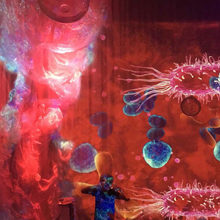Microbiology Today May 2020: Why Microbiology Matters
05 May 2020

The May 2020 issue of Microbiology Today is available to read online now. The theme of this special anniversary edition is ‘Why Microbiology Matters’, and it includes seven sections containing articles that provide examples of the many ways microbiology is important to our lives and the world around us.
In 2018 we launched a call to the community to nominate a discovery, event or activity that best highlights why microbiology matters. From the submissions received from throughout the microbiology community, we have created seven focus areas, which form the sections of scientific articles in this issue and complement a series of digital content hubs on our website. Each section examines an important theme in detail, and contains an introductory article followed by two articles on specific areas within this theme.
The title of the first section is ‘Unlocking the world of microbiomes: exploring microbial communities’. It is introduced by Lindsay Hall, with an article that highlights the concepts and importance of microbiome communities. Jack Gilbert follows on with his article, which looks at microbiome research in industry and the environment, focusing on the potential of schemes such as the Earth Microbiome Project and the development of a global ‘seed bank’. Sharon Huws then outlines the importance of microbiomes in agriculture, focusing specifically on the use of ‘omics technologies in this area of research.
The second section, ‘Understanding bacteria and challenges in microbiology’, starts with an article by Laura Bowater. She discusses the potential alternative technologies that may be of use in the fight against antimicrobial resistance (AMR). Next, Thomas James O’Brien and Martin Welch take us on a tour through the world of biofilms, looking at their role in AMR but also some of their useful functions. Anna Trego and Vincent O’Flaherty also focus on the positive roles of bacteria in their article, using food and wastewater as two key examples.
Next is a section on ‘Vaccines: the global challenge for microbiology’, which starts with an introduction by Norman Fry, who emphasises the vital importance of vaccines. Kate Cuschieri and Heather Cubie look at a specific example in their article on human papillomavirus (HPV), which provides an overview of the development of the vaccines, the vaccination programmes and the related impact on public health. Vanessa Terra and Brendan Wren then look in more detail at the development and production of vaccine candidates, focusing in particular on glycoconjugate vaccines.
A section on ‘Microbes and where to find them’ follows, starting with an article by Katherine Duncan, who introduces microbial life at the extremes. Mara Leite then takes us into space, with a focus on how extremophilic microbes could be used to develop and support long-term human settlement on other planets. Penny Hirsch concludes the section with her article, which discusses soil microbes and their roles in processes that directly affect the gases present in the Earth’s atmosphere.
The next section, ‘Microbiology and genetics’ begins with an introduction by Charles Dorman who outlines some of the key milestones and future perspectives in the study of microbes and genetics. Qaiser Sheikh and David Hornby’s discussion considers the roles of restriction enzymes and CRISPR-Cas. Peter Fineran and Nils Birkholz also focus on CRISPR-Cas in their article, discussing the system and its uses, as well as the ethical challenges it poses.
‘New frontiers in microbiology’ is the next section, which starts with an examination of the tree of life in an article by Bryn McCulloch and Thorsten Allers. Andre Holzer, Shelby Newsad, Nhan-An Tran, Ellen Harrison and Alison Smith look at the complex interactions between different microbes living within aquatic communities. André Antunes then examines how astrobiology is contributing to the search for extra-terrestrial life.
The final focus area is ‘Understanding viruses and challenges in microbiology’. Nicola Stonehouse and Natalie Kingston start with their article, which focuses on viruses and the diseases they cause. Next, Hollie French, Elizaveta Elshina, Emmanuelle Pitre and Aartjan te Velthuis discuss the different stages of virus life cycles, pointing to the negative, but also positive impact they can have within the organisms they infect. The final article of the issue is written by David Bhella, who discusses the techniques used to study the structural biology of viruses.
This issue also contains a look back at the last 75 years of the Society’s history, updates about next year’s Annual Conference, advice on entrepreneurship and more.
View the latest issue online.
Find out more about the Why Microbiology Matters project in our podcast.
Image: Dr Chloe James.
